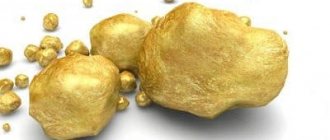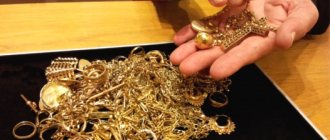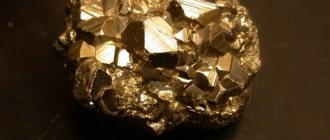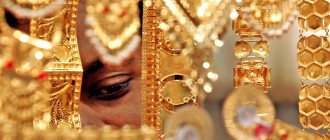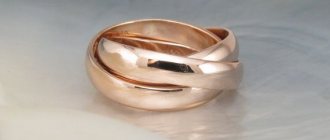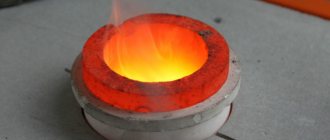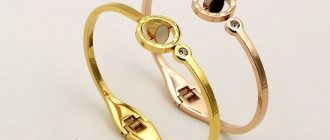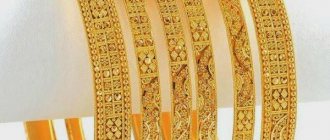Category “Investing in gold”
Today, counterfeiting jewelry is an extremely profitable business. After all, gold jewelry is small in size. They are convenient for smuggling. They have a high cost per unit volume and, moreover, their production does not require large premises and very complex technologies.
There are many ways to imitate gold.
The simplest is the so-called gypsy gold - copper polished to a golden shine. But usually different alloys are used. Sometimes these are very simple fakes made of brass, roundel, bronze, copper and even iron and aluminum. However, most often, to imitate gold, alloys are used that only an experienced jeweler or expert can distinguish from real gold.
Thus, the following counterfeits are often passed off as precious yellow metal:
7 aluminum bronze (aufir, aural, aufor) – a golden-yellow alloy (consists of 90 parts copper and 10 parts aluminum);
7 bathbronze (bathbronze) – an alloy of bronze and tin (used for gilding and casting of artistic and industrial products;
7 bathmetall – an alloy alloyed with zinc (used in England for the production of tableware);
7 vermeil (vermeil) – fire-gilded silver;
7 hamiltonmetall (hamiltonmetell) - an alloy of 66.7 parts copper and 33.3 parts zinc, golden yellow in color;
7 goldin (goldin) – an alloy of copper and aluminum (used in Germany for the manufacture of cheap jewelry);
7 durametall (durametall) – an alloy of copper, zinc and aluminum of golden-bronze color;
7 gold musiv - tin sulfide plastics with a golden luster (used for gilding; not corroded by sulfur and hydrogen sulfide, do not turn black);
7 Mannheim gold - an alloy of 83.6 parts copper, 9.4 parts zinc and 7 parts tin, painted gold;
7 mosaic gold - an alloy of 66 copper and 34 zinc (has a hint of native gold); oreide
7 “French gold” - a gold-colored alloy of 80 parts copper, 15 parts zinc and 5 parts tin;
7 pinchbeck, “English gold” - an alloy of copper and zinc (used for the manufacture of publicly available jewelry, costume jewelry, and frames); 7 similor - an alloy similar to gold (usually consisting of 83.7 parts copper, 9.3 parts zinc and 7 parts tin);
7 tombak - an alloy of copper and zinc of various compositions (usually 90 parts copper and 10 parts zinc) with a beautiful golden color;
7 electron – an alloy of gold and silver of various compounds;
7 “alloy of gold with titanium” - an alloy without gold (costume jewelry), but in color reminiscent of 585 gold (usually massive jewelry is made from it).
People are often sold on tombac, an alloy very similar to gold.
Selling tombak under the guise of gold is very popular in Turkey, where you can even “get” this alloy in a large store. Fake gold is often found in Israel, Italy, China, and the UAE. Pseudo-gold smuggling usually comes from these countries. Low-quality gold items break easily, but jewelers won’t repair them because... non-gold alloys cannot be soldered.
Recently, a lot of fake gold has appeared in Hong Kong and Vietnam (an alloy of gold with tungsten and other heavy metals).
Falsification is very common, when part of the product is made of real gold, and part is made of an alloy of copper, tin and zinc. For example, a lock on a gold chain with a stamp is indeed gold, but the rest of the part is made of a “gold-like” alloy.
Of course, genuine gold must have the appropriate hallmark. But, for example, in Turkey, the store will put the sample you want on the product right in front of you. It is clear that other jewelry can have any stamp.
Having been burned by fake yellow imported gold, Russians began to appreciate domestic red gold again. However, color today does not indicate the place of manufacture. Foreign importers, having studied the demand of Russian buyers, quickly switched to the production of red gold.
In order not to torment yourself with doubts and not to be disappointed with an expensive purchase, you should not buy gold second-hand or in dubious stores. It is better to go to large stores and purchase products from well-known Western companies and well-known Russian factories. Although the price of such gold will be higher, the likelihood of buying a fake will be relatively small.
It is worth remembering that according to official statistics, about 60% of gold items imported into Russia have a gold content significantly lower than the standard indicated on them, and more than half of the gold jewelry sold in Russia is fake.
If you have doubts about the authenticity of the gold, then you should take the product for examination, for example, to a pawnshop. If suspicions are confirmed, the fake gold jewelry can be returned to the same store where it was purchased.
Read also: Metal drill geometry
The attitude towards imitation gold is twofold. On the one hand, this is still a fake, on the other hand, the appearance of the product or its content can be so noble that it more than compensates for the obvious lack of gold. This applies to the gilding of temple domes, coating of objects of art, and elements of exclusive furniture with materials similar to gold.
The history of counterfeits and legal substitutes for gold is so rich in facts that when asking the question: what is the name of a metal similar to gold, you can get an answer that will take more than a dozen pages. We will consider the most famous pseudo-gold alloys used in our time. So what material is similar to gold?
The first and most honest specimen will be Abyssinian gold. The presence of microscopic fractions of precious metal in the composition of the metal gives it some right to be called gold.
The main problem of any imitation is low corrosion resistance. Ethiopian jewelers, who were brilliant swindlers, or simply enterprising chemists, created an alloy similar to gold, which did not become covered with patina for a long time and could pass for gold in the eyes of even an experienced specialist. The new material was named after the old name of the country - Abyssinian. The basis of the alloy was copper, the content of which was almost 90%. The remaining parts were supplemented by zinc, and gold was added to corrosion resistance in very small doses - only 0.5%. This amount of precious metal was enough to make Abyssinian gold resistant to external influences.
Abyssinian gold is used to make “gold” metal crowns, in microelectronics and in jewelry.
This metal, similar to gold, is called, like its precious prototype, gold, with the prefix French. In this alloy, the original is completely absent and they are united only by color.
Another feature that reveals the imperfection of most fakes is the lack of the sparkling shine inherent in gold. However, talented chemists have created a metal alloy from copper, zinc and tin, which reproduces both the yellow-golden color and shine of precious gold. Its name among jewelers is Oraide or French gold. The percentage of components in this alloy is: 58% Cu, 25% Zn, 17% Sn.
French gold is used to make haberdashery, jewelry, and is used as a material to create art objects. On them you will not find a seal with the hallmark corresponding to gold products.
The brass-based alloy, known since the 17th century, looks like gold and behaves like gold. Tompak is slightly susceptible to corrosion and has a good shine; its color, like the color of gold, varies from yellow with red to light gold. The shades of the metal depend on the amount of copper, the usual content of which in the alloy is up to 90%. The amount of zinc is less than 10%. This metal, similar to gold, does not react to magnets.
Tompak has several additional names, among which the most common are similor, oreid and chrysorin.
The metal is used to make expensive furniture fittings, “gilded” decorative elements, dishes, interior items, insignia, sewing items, parts of wind musical instruments, coins and medals. In Russia, tombak is used as the basis for the main school award - the gold medal.
The combination of titanium with nitrogen gives rise to a special alloy - titanium nitride. This material, similar to gold, has truly unique characteristics. It is resistant to all types of atmospheric influences, does not react to hydrochloric and sulfuric acid, does not melt at temperatures up to 800 degrees, and does not lose its properties over time.
Thanks to these qualities, titanium nitride is used to imitate the effect of gilding church domes, interior decoration items, elements of exterior decoration of buildings and decorative metal structures.
Customers of large outdoor advertising projects, asking what metal is similar to gold, also receive an offer to coat their advertising installations with titanium nitride.
This beautiful and uniquely durable alloy is used to cover the surface of the cutting edges of medical instruments, tableware and decorative edged weapons.
By knowing that these imitations of gold are available, you are already protected as a buyer because you know that not everything is gold that looks like it. In order to learn how to distinguish fakes, we also recommend that you read our article on how to check gold for authenticity.
Nowadays it is difficult to surprise anyone with a counterfeit product. Absolutely everything is counterfeited - from food to money, jewelry and works of art. And it is counterfeit jewelry that costs buyers the most. According to average statistical data, in Russian jewelry stores, imitation of the old precious metal - gold - already reaches half of the total number of products presented. And an imitation of an old gold product will definitely cost more than fake newfangled jewelry. How can you buy a real product made from old gold, and not a cheap alloy that looks like a noble metal?
Read also: Repair of chainsaw brake Shtil 180
Tompak - Steel - Tompak
TU 1881-004-55680513-2004 Multilayer tapes grade L90StL90. Specifications
Description
Multilayer bimetallic tape of the L90StL90 brand is made of low-carbon steel, clad on both sides with L90 tombac.
Compound
- The base is low-carbon high-quality steel grade 08Yu with a chemical composition in accordance with GOST 9045.
- The coating is L90 brass with a chemical composition in accordance with GOST 15527.
The thickness of the cladding layer h1 and h2 is the same for both sides and ranges from 4 to 6% of the thickness of the finished strip. At the Customer's request, the thickness of the cladding layer can be up to 10% per side.
Classification and assortment
According to the condition of the material:
- soft – M
- trained - D
- semi-solid – P
- hard - T
By type of edges:
- with cut edge – O
- without cut edge – N
Specifications
Variety
Thickness H , mm
Thickness tolerance, mm
Width B , mm
Width tolerance, mm
Length, mm
Internal diameter of the roll Øinternal, mm
Roll weight, kg
For tapes with unedged edges, the width tolerance is (±1.0) mm. It is possible to manufacture other standard sizes to an agreed tolerance.
Mechanical properties
Tape Condition
Tensile strength σ B , MPa
Relative extension
δ, %
Application
For the production of electrical and automotive products, cable armoring.
OST 3-6649-91 Tapes and strips made of Bimetal 3. Technical conditions
Description
Bimetallic tapes and strips Bimetal 3 are made of low-carbon steel, clad on both sides with L90 tombak.
Compound
- The base is low-carbon high-quality steel grade 08Yu with a chemical composition in accordance with GOST 9045, steel grade 11YUA with a chemical composition in accordance with GOST 803 or steel 11kp with a chemical composition in accordance with GOST 1050.
- The coating is L90 brass with a chemical composition in accordance with GOST 15527.
The thickness of the cladding layer h1 and h2 is the same for both sides and ranges from 4 to 6% of the thickness of the finished strip. At the Customer's request, the thickness of the cladding layer can be up to 10% per side.
What alloys are similar to gold?
To understand how to distinguish a gold-like material from a real precious metal, you need to know which alloys can mimic the appearance of old gold. If you're unlucky, you can buy one of the following alloys:
- Aluminum bronze. It is a golden-yellow alloy. Perfectly imitates gold. Approximately 90% of this alloy is copper, the rest is aluminum.
- Butt bronze. It also has a beautiful golden yellow hue. Usually used for the manufacture of various artistic products. Unscrupulous sellers may pass it off as precious metal to gullible buyers.
- Batmetal. In some countries, tableware is made from it. This alloy imitates gold quite well.
- Belgium. This alloy is more similar to platinum. Includes iron, nickel and chromium. There is no hint of precious metal.
- Vermeil is silver processed by fire. During processing, the metal becomes similar to gold. But paying as much for silver as gold costs is not the best option.
- Hameltonmetal is an alloy of zinc and copper. It has a beautiful golden yellow hue. It is used for gilding of various products.
- Goldin. It is an alloy of aluminum and copper. In some countries, budget jewelry is made from it. Although the metal is beautiful, it has nothing in common with gold except its appearance.
- Durametal. This alloy consists of aluminum, copper and zinc. The ingredients are mixed in certain proportions and subjected to special processing. The final product has a beautiful golden-bronze hue. But again, this is not gold.
- Gold leaf. These very thin sheets are used for gilding a variety of wooden and metal products, as well as in other areas.
- Musiv is a sulfide tin with an attractive golden luster. Typically used for gilding. Its only advantage is that the material does not turn black over time.
- Mannheim gold. It is an alloy of zinc, copper and tin. It has a “gold” coloring.
- Mosaic gold. This alloy consists of zinc and copper. It has an original shade of native gold.
- False gold is an alloy of copper with a layer of precious metal.
- Oraide. This alloy consists of zinc, copper and tin. Sometimes iron is added. Used for casting inexpensive jewelry.
- Pinchbeck, which is an alloy of zinc and copper. Used for the production of budget jewelry. Passed off as gold by unscrupulous traders.
- Platinor is an alloy of silver, copper, nickel, zinc and platinum. The percentage of precious metals is so small that unscrupulous sellers stand to gain big by passing off such items as real gold.
- Similor. This alloy contains zinc, copper and tin. Usually the products are plated with gold.
- Tompak is one of the alloys most often passed off as gold. It contains zinc and copper. Has a beautiful shade. Thanks to copper it is resistant to corrosion.
- Electron. It contains silver and gold. In ancient times, the alloy was used to make coins.
Return to contents
What is pyrite?
Pyrite is called iron pyrite. This is a material that has also been nicknamed "fool's gold". All because during the conquest of America by the conquistadors, this particular stone was mistaken for gold, they filled all the holds of the ship with it and brought it to Europe, where they discovered a fake. The real name of the mineral is translated as “stone that strikes fire.” Pyrite was confused with gold during the gold rush and the search for precious metals in Alaska. But such cases occurred less frequently, since gold miners were more literate than knights.
gold bar
The meaning of jewelry hallmark
It is important to consider that even the presence of a sample does not guarantee that you are buying a precious metal. If with Russian markings the buyer is still a little clear (usually these are numbers next to a female profile or a star and a hammer and sickle), then with samples according to foreign standards everything is much more complicated.
And the knowledge that 14-karat gold corresponds to the “domestic” 585th standard, and a product made of 18-karat material can be regarded as 750th standard, practically does not help in the matter. Samples are samples, but no one is safe from buying a chain, of which, at best, half is made of precious metal, and the rest is made of various kinds of alloys.
It is very difficult to verify authenticity. Not every jewelry detector responds. When going to the store to buy a gold item, take with you some jewelry made of the same material. Throw your product and the product you are looking at into the display case and compare the sound it makes. If the sounds are similar, you've likely struck real gold.
Psychological methods can also be used. Try to “pick” the surface of the product you are looking at a little so that the consultant can see it. You won’t do anything bad to the product, but you can understand a lot from the seller’s reaction.
Definition
What are bimetals? One of the layers of such materials is most often inexpensive steel. The second layer is made of expensive non-ferrous or even noble metals. Composites of this type are usually used when it is necessary to impart special properties to the product. Also, the use of such materials in various fields helps to save on aluminum, copper, bronze, silver, etc.
Thus, what a bimetal is is clear. This is a composite, most often consisting of two layers. Such materials differ from ordinary ones in special properties. The layer of cheap steel in bimetals is always called the base layer. A layer of expensive material is cladding.
The page provides examples of photos of different types of bimetals and products made from them. Materials of this type are actually used very widely in the national economy.
This is interesting: Brass - composition, grades, characteristics of the alloy
Jewelry quality assessment
Checking the quality of jewelry products in Russia falls under the authority of the State Assay Office. Theoretically, products with its hallmark are real gold. However, in practice everything is much more confusing. The problem is that most jewelry is checked superficially. Typically, only the layer of coating scraped from the surface of the jewelry is analyzed. Thus, the seal only indicates that the top layer of the jewelry is actually made of gold. But what is underneath this layer is already a mystery.
Read also: Screwdriver torque regulator
A knowledgeable user might argue that precious items are cut, after which the cut is subjected to detailed chemical analysis. Yes, it is. But only one product from a whole batch of the same type undergoes such testing. So if the tested sample is made of gold, and the rest of the products are made of unknown alloys, the assay office is no longer responsible for this.
It is also important to take into account that only about half of the products in the country are currently labeled accordingly. If we take into account the specifics of the activities of the mentioned assay office, we can come to the disappointing conclusion that there are even fewer high-quality jewelry on sale.
And there is nothing surprising about this. Counterfeiting jewelry is very profitable. They are small in size and sell for a high price per unit volume. It is very convenient for smugglers to work with such products. Their production does not require large production facilities. And complex technological operations, as a rule, are also not required. So the shadow jewelry business is developing and thriving. Therefore, you need to carefully prepare for your purchase.
Production methods
Methods for obtaining tombak have expanded significantly since its discovery, but the essence of each of them comes down to a single scheme.
- The composition is heated in an electric oven to 1300–1400 degrees. With such heating, silicate is released, floating to the surface of the alloy, which makes it possible to remove it from there without unnecessary difficulties.
- The resulting metal is poured into a container and purged with oxygen. This stage requires the use of special equipment. This treatment provokes the release of thermal energy in large quantities and triggers a chemical reaction.
- At this stage, copper is formed, which contains many impurities, which reduces its properties.
- The composition is subjected to electrical cleaning using acidified copper sulfate.
- Zinc is added to molten copper to produce a strong alloy with high corrosion resistance.
The process of obtaining tombak is complex, labor-intensive and energy-consuming. This explains the high cost of the metal, which is still much lower than the price of gold.
How not to buy a fake?
It is very difficult not to buy a fake. No one can give a 100% guarantee that this is real gold and not some imitation alloy. You can only work to reduce the risk of buying a fake to a minimum.
The main thing you need to clearly understand is that imitations are most often sold in dubious places such as street stalls, subway crossings, etc. It is not recommended to buy jewelry from such sellers. The attractive price in the vast majority of cases hides extremely low quality.
But no one is safe from buying counterfeit jewelry in a regular jewelry store in the city center. The legality of the seller’s work is not yet a 100% guarantee that he sells high quality products. The sale of illegal products is one of the main sources of income for many entrepreneurs.
So if you want to buy gold jewelry, then it is best to choose a large store and purchase only products from well-known domestic or foreign manufacturers. The cost of such products differs significantly from the price of gold from the metro, but, according to experts, the chance of buying a fake in such situations is significantly reduced.
If desired, you can use a special detector to verify the authenticity of the jewelry. However, even with this tool, you cannot count on a completely reliable result. They also fail. There have been cases when the detector “did not recognize” a uniquely genuine product from one of the world’s leading brands and called it “an unknown alloy.” The problem is that such devices focus on the physical characteristics of the jewelry. And these properties depend not only on the proportion of precious metal in the alloy, but also on the presence and percentage of other components in it.
So even the examination from the previously mentioned state chamber is more reliable. And the problem is not that the brand is quite difficult to fake. The main advantage of purchasing products tested by the Assay Office is that fraudsters for the most part prefer not to falsify government stamps - there is criminal liability for this. Before purchasing, carefully examine the mark under a magnifying glass. The real stamp must indicate the code of the inspection that stamped the product.
In addition to the state mark, the product usually also contains the mark of the manufacturing company. It is better if it is the name of a famous jewelry factory. As a rule, its presence is a guarantee that the sample corresponds to the declared one and that all jewelry work was performed at a high level.
Experts also recommend that you study the “wrong side” of the product. Check the workmanship of all fasteners invisible to the eye. The higher it is, the higher the quality of the product and the higher the class of the manufacturer.
Thus, buying jewelry nowadays is more like playing the lottery. The findings are extremely disappointing. There are a lot of counterfeit items on the domestic jewelry market, and it is extremely difficult even for an experienced buyer to distinguish them from the originals. If you want to buy something made of gold, do it only in large stores, giving preference to goods from well-known jewelry factories. This way you will significantly reduce the risk of purchasing a fake. Happy shopping!
Comparison by technical and user characteristics
Life time. The smooth inner surface of steel pipes, coated on the outside with an aluminum jacket, does not contribute to the deposits of lime and salt deposits.
The typical service life of bimetallic radiators is more than 20 years, and here their only rival is cast iron.
It is believed that due to unreliable paint and varnish coating and insufficient corrosion resistance of steel, the service life of steel appliances is lower and ranges from 15-20 years.
Heat transfer from radiators is a relative concept. Aluminum has a high heat transfer coefficient. The bimetallic section has a heat output of about 200 W. For steel sections of the same area, this figure is almost two times lower.
Corrosion resistance:
- Both options have steel inside, which makes them equally vulnerable in conditions of central heating, when utilities drain water for the summer. In manor houses with local heating, the rusting process will occur much more slowly;
- On the outside, bimetal has an obvious advantage. A layer of non-corrosion aluminum effectively protects steel from oxidation;
- Steel batteries, due to poor quality paintwork, rust on the outside. It is strictly not recommended to install them in damp areas, where their service life can quickly be shortened.
High pressure will not interfere with the efficient operation of bimetallic devices that can withstand barometric loads of up to 40 atm. Therefore, central heating with its pressure drops and surges is perceived normally by steel radiator pipes.
This cannot be said about steel panels, which are usually designed for operation at 6 atm. They can withstand the operating pressure of the boiler room, but not surges and drops, and are therefore recommended for homestead construction with local heating.
Tubular radiators are more durable and adapted to the conditions of centralized heating. They can withstand up to 16 atm.
Installation options and ease of installation:
- Both options are connected to the heating system using threaded couplings, and the steel-to-steel contact is considered quite reliable;
- Bimetallic, not so bulky and therefore considered more convenient for installation;
- Thanks to aluminum, they are lighter, which means that installing them and securing them to the wall will require less effort.
Titanium nitride
The combination of titanium with nitrogen gives rise to a special alloy - titanium nitride. This material, similar to gold, has truly unique characteristics. It is resistant to all types of atmospheric influences, does not react to hydrochloric and sulfuric acid, does not melt at temperatures up to 800 degrees, and does not lose its properties over time.
Thanks to these qualities, titanium nitride is used to imitate the effect of gilding church domes, interior decoration items, elements of exterior decoration of buildings and decorative metal structures.
Customers of large outdoor advertising projects, asking what metal is similar to gold, also receive an offer to coat their advertising installations with titanium nitride.
This beautiful and uniquely durable alloy is used to cover the surface of the cutting edges of medical instruments, tableware and decorative edged weapons.
By knowing that these imitations of gold are available, you are already protected as a buyer because you know that not everything is gold that looks like it. In order to learn how to distinguish fakes, we also recommend that you read our article on how to check gold for authenticity.
Secrets of transmutation.
In all centuries, scientists, not only chemists, but also physicists, as well as medieval alchemists, struggled with the question: is it even possible to scientifically obtain another metal similar to gold? Atomic scientists have proven that at the atomic level, one metal can acquire the properties of another by transmuting chemical elements located next to each other on the periodic table (for example, mercury and platinum can transform into stable gold as a result of a reaction).
By the way, this is one of the very first and most reliable ways to obtain gold from metal. Back in the Middle Ages, alchemists cheated like this in front of kings and emperors. Gold powder dissolved in mercury, then the mercury evaporated and a gold bar remained.
All other ways to obtain gold by manipulating various metals (iron, tin, lead) can only lead to the production of an alloy with a small admixture of gold. Most often, this is exactly what scammers achieve, whose main task is to make the fake as high quality as possible.
Some scientist even jokingly summed up the “scientific” basis for the similarity of bronze to gold. He said that if you add up the charges of the nuclei of the alloy components (29 for copper and 50 for tin), you will certainly get “gold”.
However, in order not to get into trouble when buying real gold jewelry, it is advisable to know what alloys form a metal similar to gold. Although even experts cannot always distinguish a fake, especially if gold is actually added to the alloy. In this case, they say that this is gold of a very low standard. .
